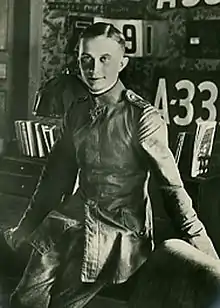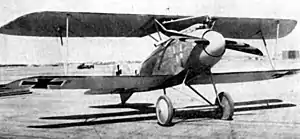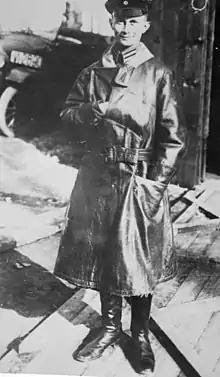Kurt Wolff (aviator)
Oberleutnant Kurt Robert Wilhelm Wolff (6 February 1895 – 15 September 1917) was one of Imperial Germany's highest scoring fighter aces during World War I. The youthful ace originally served in three bomber units before being picked by Manfred von Richthofen for fighter aviation. Under the tutelage of Richthofen, Wolff would shoot down 33 enemy aircraft in four months, including 22 victims during Bloody April, 1917. On 6 May 1917, after his 29th victory, he was transferred to command Royal Prussian Jagdstaffel 29. When Richthofen moved up to become the wing commander of the Flying Circus and his replacement as squadron commander was killed, Wolff was transferred to command his old squadron. Wolff was killed in action, aged 22, while flying a Fokker Triplane prototype.
Kurt Wolff | |
|---|---|
 Note the war souvenirs in the background. | |
| Nickname(s) | delicate little flower |
| Born | 6 February 1895 Greifswald, Pomerania |
| Died | 15 September 1917 (aged 22) near Moorslede, Belgium |
| Allegiance | |
| Service/ | Luftstreitkräfte |
| Years of service | 1912–1917 |
| Rank | Oberleutnant |
| Unit | Kampfstaffel 26 (Bomber Squadron 26); Kampfgeschwader 7 (Combat Squadron 7); Kampfgeschwader 40 (Combat Squadron 40); Royal Prussian Jagdstaffel 11 (Hunting Team 11) |
| Commands held | Royal Prussian Jagdstaffel 29 (Hunting Team 29) Royal Prussian Jagdstaffel 11 (Hunting Team 11) |
| Awards | Prussian: Pour le Mérite House Order of Hohenzollern Iron Cross Bavarian: Bavarian Military Merit Order, 4th Class with Swords |
Early life
Kurt Wolff was born in Greifswald, Pomerania. He was orphaned as a child and was raised by relatives in Memel, East Prussia. Wolff enlisted in the Bavarian Army in 1912 at the age of 17, joining a transport unit, Railway Regiment Nr. 4. He was still with this regiment when World War I began. He received a commission on 17 April 1915, and he transferred to the Luftstreitkräfte (Air Force) in July.[1]
Fighter pilot
Training and first posting
Wolff's first flight was almost his last. The instructor crashed the aircraft, killing himself; Wolff's shoulder was dislocated. Eventually, Wolff received his pilot's badge in late 1915 and was assigned to a series of two-seater bomber units. He was originally assigned to Kampfstaffel 26 (Bomber Squadron 26) of Kampfgeschwader 5 (Combat Squadron 5), followed by service with Kampfgeschwader 7 (Combat Squadron 7) and Kampfgeschwader 40 (Combat Squadron 40).[1]
On 5 November 1916 he was posted to La Brayelle Airfield in northern France to join the then victoryless Royal Prussian Jagdstaffel 11 (Hunting Team 11).[2] For months, Wolff, like most of his comrades in the squadron, had no success in the air. That changed when command was given to the Red Baron, Rittmeister (Cavalry Captain) Manfred von Richthofen. Under the Red Baron's leadership, Jagdstaffel 11 began to score victories, and Wolff became an excellent scout pilot. Like his commanding officer, Wolff soon became an avid collector of souvenirs from the aircraft he shot down. Wolff's room at his airfield soon became decorated with serial numbers, airplane parts and machine guns salvaged from his victims.[3]

Like the rest of the Jagdstaffel 11 aircraft, Wolff's Albatros D.III was painted in the unit's red livery. To this, he added individual markings for inflight identification by having his plane's elevators and tailplane painted green.[4] He first claimed an aerial victory on 6 March 1917, a Royal Aircraft Factory B.E.2d of No. 16 Squadron RFC. Four more followed during March, making Wolff an ace.[5]
Bloody April
By the end of March 1917, the Royal Flying Corps held a numerical edge over the Luftstreitkräfte of about two to one. The German aircraft numbered about 195; about half these could be used to attack other planes. By contrast, the British were fielding about 365 airplanes; a third were single-seat fighters. However, despite their superior numbers, the British aircraft were technologically inferior to the German fighters. Nevertheless, the British pushed their air offensive over the German lines to maintain their air superiority during April 1917, despite ongoing heavy casualties among their aircrew.[6]
The British lost almost 300 aircraft to German action during Bloody April, 1917; 89 of those were credited to Jagdstaffel 11. Kurt Wolff shot down 22 of them.[5] Besides the individual victories throughout the month, Wolff would score multiple victories on five April days. Most notable was Friday, 13 April, when Wolff shot down four British airplanes from four different squadrons on four sorties.[7] Also notably, he scored three victories on 29 April 1917, including Major H.D. Harvey-Kelly, commander of No. 19 Squadron RFC.[8] Wolff ended the month with his victims numbering 29. Having previously earned both classes of the Prussian Iron Cross, Wolff was awarded that kingdom's Knight's Cross with Swords of the Royal House Order of Hohenzollern on 26 April.[5]
Wolff in command
Wolff was awarded the German Empire's most prestigious award, the Prussian Pour le Mérite, on 4 May 1917. Two days later, with his victory total at 29, Wolff left his pilot's assignment with Jagdstaffel 11 when he was promoted to command Royal Prussian Jagdstaffel 29,[5] replacing Leutnant Ludwig von Dornheim who had recently been killed in action.[9] Wolff shot down a French SPAD on 13 May and a No. 60 Squadron Nieuport 17 on 27 June before he returned to Jagdstaffel 11 as its commander in July 1917.[5] Wolff was Richthofen's selection to replace Leutnant (Second lieutenant) Karl Allmenroeder, who had fallen in combat.[2]
Wolff's youthful looks and frail physical stature masked his deadly skills as a combat pilot. As the Adjutant of Jagdstaffel 11, Karl Bodenschatz's estimate of Wolff was:
"Jasta 11: Leutnant Kurt Wolff. At first glance, you could only say 'delicate little flower'. A slender, thin little figure, a very young face, whose entire manner is one of extreme shyness. He looks as if you could tip him backwards with one harsh word. But below this friendly schoolboy's face dangles the order Pour le Mérite. And so far, these modest looking eyes have taken 30 enemy airplanes from the sky over the sights of his machine guns, set them afire, and made them smash to pieces on the ground. This slender youth is already one of the best men of the old Richthofen Staffel 11."[10]
During Wolff's assignment to Jagdstaffel 29 as its commander, Jagdstaffel 11 was one of four squadrons incorporated into the first German fighter wing, Jagdgeschwader I, on 24 June 1917. Manfred von Richthofen was promoted out of squadron command to lead the new wing. Inheriting Richthofen's Jagdstaffel 11 command and leading this squadron as part of the new wing, Wolff downed a RE-8 of No. 4 Squadron RFC and a Sopwith Triplane of No. 1 Naval Squadron in early July for his final victories, the 32nd and 33rd.[5] However, on 11 July Wolff was shot in both his left hand and left shoulder by gunfire from a Sopwith Triplane flown by future ace Flight Sub-Lieutenant Herbert Rowley of No. 1 Naval Squadron. Wolff crash landed his aircraft on the Courtrai railway line. The crash ripped off the undercarriage and flipped the aircraft over. The wreck came to rest with Wolff's head within inches of smashing on a metal fence. His rescuers toted him off to the hospital. Wolff would not return from sick leave until 11 September.[11] The day after his return, he was promoted to oberleutnant (lieutenant).[5]
Final fight
The first two Fokker Triplane prototypes had been allocated to Jagdgeschwader 1. Upon his return on 11 September, Wolff was eager to fly one of the prototypes in Richthofen's absence. Four days later, on 15 September he found his opportunity. Despite heavily overcast skies, he took off in Richthofen's prototype Triplane. He was flying the lone Triplane with a patrol of five Albatros fighters.[12]

Meanwhile, three new Sopwith Camels of No. 10 Squadron Royal Naval Air Service, sallied forth from their lines on an offensive patrol. Somewhere in the vicinity of Moorslede, Belgium, at 16.30 hours the trio was the target of a diving attack by Wolff and his patrol. In the confusion of the dogfight, the British pilots mistakenly thought four triplanes were involved. As Wolff singled out a Camel to shoot down, he was suddenly fired on from behind by Flight Sub-Lieutenant Norman MacGregor. MacGregor fired a quick burst from 25 yards range, then had to zoom to avoid colliding with the Fokker. Glancing behind him and downwards, he noted only that Wolff was in a vertical dive. McGregor's combat claim was for an 'out of control' victory.[13]
It seems probable that Wolff was killed by MacGregor's bullets in midair and was already dead when his Triplane crashed and burst into flames north of Wervik near Moorslede at 17.30 hours (German time).[14][note 1] Wolff's remains were taken back to Memel for burial. His interment in a military ceremony included display of his native Bavaria's Military Merit Order, 4th Class with Swords, in addition to his Prussian awards.[14]
Footnote
- British and German times often differed by an hour during the Summer. This may explain the time discrepancy of the reports of the combat.
Endnotes
- Franks & Giblin (2003), p. 141.
- "Jasta 11". The Aerodrome. Retrieved 13 September 2020.
- Franks & Giblin (2003), pp. 141–142, 162.
- Franks (2000), p. 32.
- Franks, Bailey & Guest (1993), p. 233.
- Kilduff (1997), p. 76.
- Franks (2000), pp. 32–33.
- Franks & Giblin (2003), pp. 141–176.
- "Jasta 29". The Aerodrome. Retrieved 13 September 2020.
- Bodenschatz (2008), pp. 14–15.
- Franks & Giblin (2003), pp. 186–187.
- Franks & Giblin (2003), p. 187.
- Franks & Giblin (2003), pp. 187–188.
- Franks & Giblin (2003), p. 188.
References
- Bodenschatz, Karl (2008). Hunting with Richthofen Jagd in Flanderns Himmel: The Bodenschatz Diaries: Sixteen Months of Battle with JG Freiherr von Richthofen No. 1 Foreword by Herman Goring, Issue 1. London, UK: Grub Street Publishing. ISBN 978-189869-746-6.CS1 maint: ref=harv (link)
- Franks, Norman (2000). Albatros Aces of World War I. Oxford, UK: Osprey Publishing. ISBN 978-1-85532-960-7.CS1 maint: ref=harv (link)
- Franks, Norman; Bailey, Frank; Guest, Russell (1993). Above the Lines: A Complete Record of the Aces and Fighter Units of the German Air Service, Naval Air Service and Flanders Marine Corps 1914–1918. London, UK: Grub Street Publishing. ISBN 978-0-948817-73-1.CS1 maint: ref=harv (link)
- Franks, Norman; Giblin, Hal (2003). Under the Guns of the Kaiser's Aces. London, UK: Grub Street Publishing. ISBN 978-1-904010-02-9.CS1 maint: ref=harv (link)
- Kilduff, Peter (1997). The Red Baron Combat Wing: Jagdgeschwader Richthofen in Battle. London, UK: Arms and Armour Press. ISBN 978-1-854092-66-3.CS1 maint: ref=harv (link)
External links
| Wikimedia Commons has media related to Kurt Wolff. |
